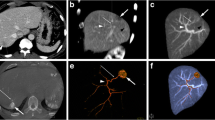Abstract
Background
To evaluate the detectability of hepatocellular carcinoma (HCC) by computed tomography during arterial portography (CTAP) using cone-beam CT technology (CBCTAP) by comparing it with conventional CTAP.
Methods
Forty-four HCC lesions (mean diameter 1.9 ± 1.1 cm) of 24 patients who sequentially underwent conventional CTAP and CBCTAP during the same angiography session were evaluated. CBCTAP findings of each tumor were classed into three grades as compared to conventional CTAP: optimal; suboptimal; and nondiagnostic.
Results
All CBCTAP images had image artifacts from the catheter placed in the superior mesenteric artery and enhanced portal veins. Additionally, the contrast between HCC lesion and surrounding liver parenchyma of CBCTAP images was less than that of CTAP images. Of the 44 tumors, findings of 31 nodules (mean 2.2 ± 1.2 cm) (70.5%) were classed as optimal. Eight nodules (mean 1.4 ± 0.8 cm) (18.2%) were classed as suboptimal. Five nodules (mean 1.0 ± 0.1 cm) (11.4%) including two located in the outside of field of view were classed as nondiagnostic.
Conclusion
CBCTAP had sufficient image quality to detect almost all small HCC lesions compared to conventional CTAP and could depict approximately 89% of HCC nodules, including eight suboptimal lesions.





Similar content being viewed by others
References
Matsui O, Kadoya M, Suzuki M, et al. (1983) Work in progress: dynamic sequential computed tomography during arterial portography in the detection of hepatic neoplasms. Radiology 146:721–727
Matsui O, Kadoya M, kameyama T, et al. (1991) Benign and malignant nodules in cirrhotic livers: distinction based on blood supply. Radiology 178:493–497
Ishijima H, Koyama Y, Aoki J, et al. (1999) Use of a combined CT-angiography system for demonstration of correlative anatomy during embolotherapy for hepatocellular carcinoma. J Vasc Interv Radiol 10:811–815
Binkert CA, Alencar H, Singh J, et al. (2006) Translumbar type II endoleak repair using angiographic CT. J Vasc Interv Radiol 17:1349–1353
Hirota S, Nakao N, Yamamoto S, et al. (2006) Cone-beam CT with flat-panel-detector digital angiography system: early experience in abdominal interventional procedures. Cardiovasc Intervent Radiol 29:1034–1038
El-Sheik M, Heverhagen JT, Alfke H, et al. (2001) Multiplanar reconstructions and three-dimensional imaging (computed rotational osteography) of complex fractures by using a C-arm system: initial results. Radiology 221:843–849
Linsenmaier U, Rock C, Euler E, et al. (2002) Three-dimensional CT with a modified C-arm image intensifier: feasibility. Radiology 224:286–292
Author information
Authors and Affiliations
Corresponding author
Rights and permissions
About this article
Cite this article
Miyayama, S., Matsui, O., Yamashiro, M. et al. Detection of hepatocellular carcinoma by CT during arterial portography using a cone-beam CT technology: comparison with conventional CTAP. Abdom Imaging 34, 502–506 (2009). https://doi.org/10.1007/s00261-007-9254-9
Published:
Issue Date:
DOI: https://doi.org/10.1007/s00261-007-9254-9




